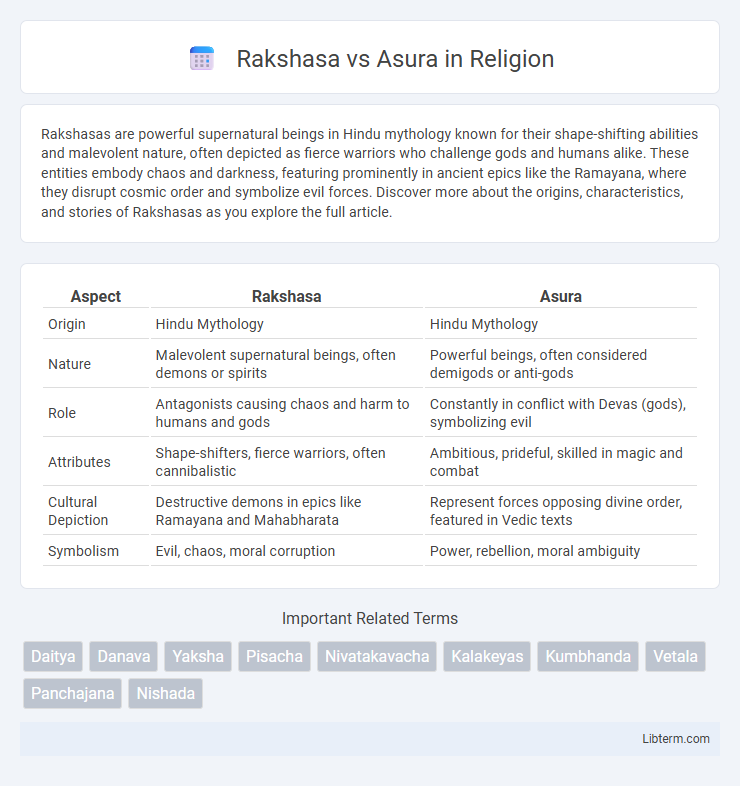Rakshasas are powerful supernatural beings in Hindu mythology known for their shape-shifting abilities and malevolent nature, often depicted as fierce warriors who challenge gods and humans alike. These entities embody chaos and darkness, featuring prominently in ancient epics like the Ramayana, where they disrupt cosmic order and symbolize evil forces. Discover more about the origins, characteristics, and stories of Rakshasas as you explore the full article.
Table of Comparison
| Aspect | Rakshasa | Asura |
|---|---|---|
| Origin | Hindu Mythology | Hindu Mythology |
| Nature | Malevolent supernatural beings, often demons or spirits | Powerful beings, often considered demigods or anti-gods |
| Role | Antagonists causing chaos and harm to humans and gods | Constantly in conflict with Devas (gods), symbolizing evil |
| Attributes | Shape-shifters, fierce warriors, often cannibalistic | Ambitious, prideful, skilled in magic and combat |
| Cultural Depiction | Destructive demons in epics like Ramayana and Mahabharata | Represent forces opposing divine order, featured in Vedic texts |
| Symbolism | Evil, chaos, moral corruption | Power, rebellion, moral ambiguity |
Introduction to Rakshasa and Asura
Rakshasas are mythological beings in Hindu and Buddhist traditions, depicted as powerful, malevolent demons with shape-shifting abilities and a penchant for deceit. Asuras are also supernatural entities from Hindu cosmology, often portrayed as antagonistic deities who challenge the gods (Devas) for control over the cosmos. Both Rakshasas and Asuras represent forces opposing divine order, but Rakshasas are primarily focused on terror and chaos, while Asuras embody the broader cosmic struggle between good and evil.
Mythological Origins and Historical Context
Rakshasas and Asuras originate from ancient Indian mythology, where Rakshasas are often depicted as malevolent spirits or demons who disrupt cosmic order, while Asuras are powerful beings frequently portrayed as adversaries to the gods (Devas). In Vedic texts, Asuras initially referred to divine or heroic figures but gradually evolved into antagonistic forces opposing the Devas, symbolizing moral dualism in Hindu cosmology. Historical context reveals that both Rakshasas and Asuras represent complex archetypes embodying chaos, temptation, and resistance against divine authority, reflecting ancient Indian cultural and religious narratives.
Defining Rakshasa: Characteristics and Roles
Rakshasas are shape-shifting supernatural beings in Hindu mythology known for their malevolent nature and prowess in combat, often depicted as fierce warriors with magical powers and a terrifying appearance. Unlike Asuras, who are primarily divine antagonists associated with cosmic power struggles, Rakshasas typically engage in acts of deception, cannibalism, and villainy against humans and gods. Their roles range from demonic antagonists to complex characters involved in epic narratives such as the Ramayana, where they serve as formidable obstacles to heroes.
Understanding Asura: Traits and Significance
Asuras are powerful supernatural beings in Hindu mythology, known for their complex nature that encompasses both benevolent and malevolent traits. Often depicted as antagonists to Devas, Asuras symbolize chaos and desire but also represent strength, ambition, and the pursuit of power. Their significance lies in embodying the duality of good and evil, illustrating moral and cosmic battles central to Hindu epics.
Rakshasa vs Asura: Key Differences
Rakshasas and Asuras, prominent beings in Hindu mythology, differ primarily in their origin and roles; Rakshasas are often depicted as malevolent demons or spirits associated with chaos, while Asuras are powerful deities or anti-gods representing moral and cosmic opposition. Rakshasas usually possess shape-shifting abilities and are known for their aggressive nature, contrasting with Asuras who embody ambition, pride, and constant rivalry with the Devas. The distinctions highlight Rakshasas as physical antagonists in epic tales, whereas Asuras symbolize broader cosmic and ethical conflicts within Vedic and Puranic traditions.
Rakshasa in Ancient Texts
Rakshasas are supernatural beings depicted in ancient Hindu texts as malevolent spirits or demons, often portrayed with shape-shifting abilities and fierce, villainous traits in epics like the Ramayana and Mahabharata. Unlike Asuras, who are considered power-seeking deities sometimes aligned with divine forces, Rakshasas are commonly associated with dark magic, cannibalism, and opposition to gods and humans. Ancient scriptures emphasize Rakshasas' role as antagonists symbolizing chaos and destruction within the cosmic order.
Asura in Vedic and Puranic Literature
Asuras in Vedic and Puranic literature are powerful supernatural beings often depicted as antagonists to the Devas, embodying qualities of pride, ambition, and chaos. In early Vedic texts, Asuras were not entirely evil but evolved into more malevolent figures in later Puranic narratives, symbolizing cosmic forces opposing divine order (Dharma). Their mythological roles highlight the continuous struggle between order and disorder in Hindu cosmology, contrasting with the Rakshasas, who are more commonly associated with demonic and flesh-eating traits.
Symbolism and Cultural Impact
Rakshasas symbolize chaos, malevolence, and supernatural evil in Hindu mythology, often representing the darker forces opposing dharma or cosmic order. Asuras embody power, ambition, and moral complexity, reflecting the ongoing struggle between good and evil within Vedic cosmology. Their cultural impact permeates Indian literature, art, and religious practices, illustrating fundamental themes of conflict, morality, and cosmic balance.
Modern Interpretations of Rakshasa and Asura
Modern interpretations of Rakshasas and Asuras often depict them as complex characters rather than mere antagonists, symbolizing internal human struggles such as ego, desire, and moral ambiguity. In contemporary literature and media, Rakshasas are portrayed with nuanced personalities, blending ferocity with vulnerability, while Asuras are seen as rebels challenging divine order, representing themes of power and resistance. These reinterpretations highlight cultural shifts towards exploring the grey areas of mythology rather than clear-cut dichotomies of good versus evil.
Conclusion: Legacy of Rakshasa and Asura
Rakshasas and Asuras both remain potent symbols of power, chaos, and spiritual conflict in Hindu mythology, representing eternal struggles between dharma (order) and adharma (disorder). Their legacy endures in religious texts, folklore, and cultural rituals, influencing contemporary interpretations of good and evil. Understanding their mythological roles offers profound insights into ancient Indian cosmology and ethical paradigms.
Rakshasa Infographic

 libterm.com
libterm.com